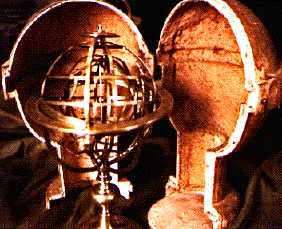A comfortable universe?
In the Renaissance, educated people did not believe the Earth was flat, but that it was in the centre of a spherical universe.
A Greek-Egyptian of the second century A. D. was largely responsible for the beliefs on the nature of the cosmos which those in the Renaissance inherited. Ptolemy collected and organized the beliefs of earlier writers, and devised an elaborate model of the universe in order to explain the movements of the sun and planets. The illustration* is of a model of the universe as conceived by Ptolemy, conveniently designed to fit in a neat carrying case. There is no sense of the infinite here.
To us it may seem a cozy place with the earth comfortably nestled in the centre of a series of spheres. The teaching of the Church, however, was that since the Fall that part of the cosmos that was at the centre -- within the sphere of the moon -- had been polluted by human sin, and was a kind of sinkhole or cesspool for all that was evil. Almost like hell. The enclosed earth, far from being a comforting shelter from the infinite, was a prison.
The spheres
The earth, according to Ptolemy, was stationary, while the spheres rotated at different speeds and in different directions. The system was arrived at by a combination of inductive and deductive reasoning. The movements of the sun from solstice to equinox, and of the moon and the planets, were carefully charted, partly because of their importance in navigation, and the fascination of the "wandering stars," the planets.
However, the explanation of their movements involved not only a series of spheres but of extra circles in order to explain what we now know to be the elliptical orbits of the planets about the sun.
The result was a highly complex system. Some spheres had to become centred somewhere other than on the earth and had to have on their surfaces circles ("epicycles") which themselves rotated. The system was virtually unchallenged for twelve hundred years.
Footnotes
-
The universe on your desktop
The armillary sphere, illustrated here, represented the universe by using hoops of metal to represent each sphere (the Latin armilla means "hoop"). It was used by astrologers and astronomers alike, both to teach and to calculate the movements of the planets.
